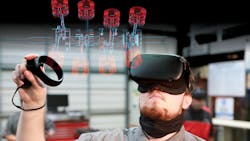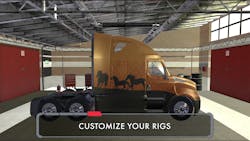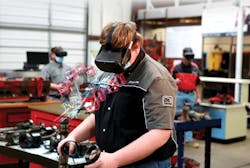How AR and VR assist in technician outreach and recruitment
More and more commercial vehicle repair stakeholders are discovering augmented reality (AR) and virtual reality (VR) technologies offer faster ways to upskill technicians and perform repair work, though their true power may lie in their “cool” quotient, and potential to make the industry more attractive to the next generation of technicians.
During the American Trucking Associations’ (ATA) Technology & Maintenance Council (TMC) 2021 Spring Meeting, the organization announced the release of an AR game designed to attract, foster, and welcome a new generation of skilled technicians to the industry.
Based on TMC’s National Technician Skills Competition, the app—called TMCSuperTech: The Game—is geared toward younger students and is available as a free download for smart devices on Apple iOS and Android platforms.“We thought that having a smart device game app would be a great way to reach a broad audience of middle and high school students to get them exposed to the idea that being a commercial vehicle technician is a valid career path,” said Robert Braswell, TMC’s executive director.
Design Interactive worked with TMC to develop and deploy the game. Matt Johnston, division head of commercial solutions at Design Interactive, explained that the game places the player in the role of a technician. Within the game, the player positions their phone screen toward a flat surface such as a floor or desk. Through the screen using AR, the player views a city landscape with trucks moving throughout. The player receives an alert when a truck is in need of repair, with the option to send the truck to the maintenance shop in the game.
“You are rewarded once to achieve sub goals and are incented to continue,” Johnston explained “Take those as the basic building blocks and add that it is fun, in some cases even addictive, student engagement increases. Any trainer would tell you that engagement is extremely important to a student’s success.”
Braswell noted that the game does more than just introduce the concepts and applications of vehicle repair management, but also presents resources to get students engaged in the industry.
“When you download the game, you can click and self-direct yourself [to resources providing information] about becoming a technician, find out about scholarships,” he said. “We are directing folks to the TechForce Foundation, which is our partner in this outreach effort, because they are very well suited toward social media that is attractive to students to get them interested in [the industry].”
Braswell added that information is available for students to learn how to talk to their parents, guidance counselors, and teachers about how this is a career they would like to pursue.
“The industry is exploring all kinds of fantastic technology from electrified vehicles to autonomous vehicles. This is just another bit of technology that can be used,” Johnston said. “I don’t know if those kids see this industry or the image of the industry as such that it reflects ‘high technology’ in comparison to the gaming industry or other places they might consider as they move forward. But it absolutely is just rife with next-generation technologies. They need to be aware of what the truth is—not just what the perceived or the assumed identity of the industry is.”
VR also coming on strong
Virtual reality technologies can also enhance the education process for those training to become diesel technicians. Educators are leveraging such technologies to further engage students with their respective curriculum. One such program is Diesel by Distance, based at Wallace State Community College in Alabama. The program integrated a VR service from TRANSFR in April.
“We are focused on our mission of helping to create that classroom to career pathway,” said Bharani Rajakumar, CEO and founder of TRANSFR.The goal of the Diesel by Distance program has been to enable more engaging distance learning. Historically, the challenge with manufacturing and the skilled trades has been the need for hands-on training and distance learning has traditionally been thought of as online video, Rajakumar noted.
“We worked to understand what are all the things that someone would need to learn in order to become part of a diesel technology career pathway. We included things like replacing shock absorbers, putting together and taking apart engines, and things of that nature,” he added.
TRANSFR designed and created virtual training simulations within a virtual training facility, allowing users to don a headset no matter their location and learn the hands-on skills aligned with the program.
Rajakumar explained that the intent is to fuse education and industry learning into one experience. He said many technicians coming out of traditional degree and certification programs are showing up to the job site unable to do what the employer would like them to do on day-one. TRANSFR creates and designs virtual reality training simulations with input from employers, so when a student puts on the headset, they learn how to do the job before they get the job. That helps the employer make sure that someone is prepared for the job as soon as possible. It also helps the trainee get insight into what it is that they will actually be doing.
TRANSFR’s virtual reality experience also offers a digital coach within the program.
“It’s perfectly fine to make mistakes,” Rajakumar said. “We assume that everyone we are working with is a beginner, and in some way that is why they are using the service, so that they can acquire the skills to move up in their career path. The digital coach helps nudge you in the right direction when you’re making mistakes and not performing based on what an employer would expect.”
Having the ability to simulate that shop experience and bring it to the student can help expedite the onboarding process and provide first-hand real-world experience that caters to students who, generally speaking, are hands-on learners. Presenting this level of immersion can help drive home that learning experience and clarify expectations as to what the career will truly require.
“There are three different types of learners: visual, auditory, and kinesthetic,” said Beth Rutter, North American director of industry and customer engagement at Tradiebot Industries. “Guess what kind of learning is typically attracted to the repair industry?”
It is the kinesthetic—or tactile—learner, she said.
“All of a sudden, the demographic that’s attracted to collision repair and working on vehicles—whether they be automotive or heavy-duty diesel—get to learn in an environment that actually speaks to them,” Rutter said. “They get it way faster than the people who have to sit down, write stuff out, and review instruction.”
About the Author
Tyler Fussner
Associate Editor | Fleet Maintenance
Tyler Fussner is Managing Editor - Community Manager at Supply Chain Connect, part of the Design & Engineering Group at Endeavor Business Media.
Previously, Fussner served as the Associate Editor for Fleet Maintenance magazine. As part of Endeavor's Commercial Vehicle Group, his work has been published in FleetOwner magazine, as well as Bulk Transporter, Refrigerated Transporter, and Trailer-Body Builders.
Fussner's May 2022 print feature 'The dawn of hydrogen trucks' was named the best single technology article in B2B by the judges of the 2022 Folio: Eddie and Ozzie Awards. Fussner was also awarded Silver in the Technical Article category for the Trade Association Business Publications International (TABPI) 2021 Tabbie Awards.
Fussner previously served as Assistant Editor for Endeavor's Transportation Group on the PTEN, Professional Distributor, and VehicleServicePros.com brands.
Fussner studied professional writing and publishing at the University of Wisconsin-Whitewater. He has experience in shop operations, is a Michelin Certified Tire Technician, and a Michelin Certified Tire Salesperson.



